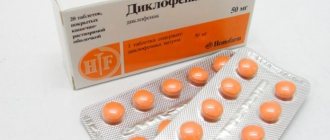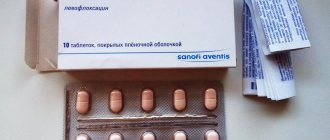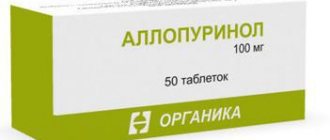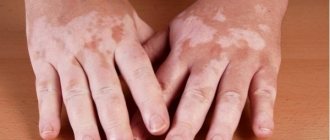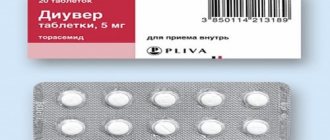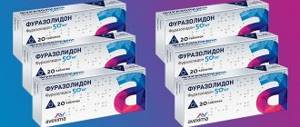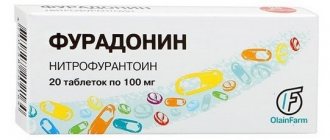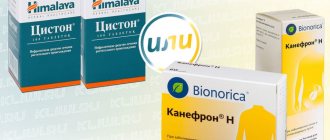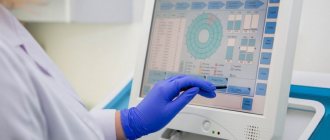One of the most effective uroseptics of plant origin is Phytolysin. The manufacturer is the Polish pharmaceutical company HERBAPOL WARSZAWA Sp. zoo Most often, doctors prescribe Phytolysin for cystitis. In complex therapy, the drug shows good results. The medicine in the form of a paste for cystitis includes herbal components that help eliminate the inflammatory process in the bladder much faster and prevent its relapse.
Form of production and composition
| Release form | Color | Smell | Taste |
| Oral paste, 100 g, in a metal tube | Green-brown | Concentrated herbal | Herbal, with notes of essential oils |
| Soft capsules, 36 pieces, dietary supplement |
The paste contains many herbs and essential oils:
- goldenrod;
- horsetail;
- knotweed (bird knotweed);
- wheatgrass root;
- parsley root;
- lovage;
- birch leaves;
- onion peel;
- fenugreek seeds;
- essential oils of peppermint, orange, pine, sage.
For thickening and flavoring effect, the composition is supplemented with:
- purified water;
- gelatin from algae (agar-agar);
- starch;
- glycerol;
- vanilla;
- ethyl parahydroxybenzoate.
Composition of capsules:
- cranberry extract – 5.5 mg in 1 capsule;
- vitamin C – 20 mg.
When they appoint...
Indications for the use of Phytolysin include diseases of the genitourinary tract. It will be effective in the following cases:
- pyelonephritis;
- cystitis;
- prostatitis;
- urethritis.
Also, the use of “Phytolysin” internally is indicated for prevention and as part of the complex treatment of urolithiasis.
Diseases of the urinary system often accompany diabetes. If the insulin administration regimen or dosage is incorrectly selected, then type 1 diabetes becomes uncompensated. For the second type, this problem occurs when the diet is not followed and the patient refuses to take glucose-lowering medications. In this case, the urinary tract becomes easily infected, urine often stagnates, bacteria can appear, stones and sand can form.
Pharmacological action, pharmacokinetics
The therapeutic effect of the paste lies in its valuable herbal composition, which has a strong antibacterial effect, soothes, relieves swelling, inflammation, normalizes metabolism, stimulates the body's immune defense, tones the bladder, prevents the formation of stones, and acts as a diuretic.
The combination of plant flavonoids helps the formation of microcenosis, detrimental to gram-positive organisms. Saponins have a detrimental effect on staphylococcus. Algucones help relieve spasms, and silicates actively affect the removal of urea and prevent the formation of stones.
Taking Phytolysin softens existing stones, after which they are destroyed inside the kidneys and then excreted from the body in the form of crushed conglomerates. The product prevents the subsequent growth of existing stones, improves filtration in the renal glomeruli, removes chlorine and sodium ions from urine, and does not affect the electrolytic balance.
In what cases is Phytolysin not recommended?
Herbal medicine may not always be beneficial. There are contraindications for which treatment with herbal medicine is highly undesirable. The instructions do not recommend taking Fitolysin paste for cystitis in the following cases:
- photosensitivity;
- phosphate urolithiasis;
- severe pathologies of the kidneys and heart;
- glomerulonephritis.
The medicine should not be used by people under the age of 18, due to the lack of additional information about the effect of the active components on the child and adolescent body.
In rare cases, the drug leads to the development of an allergic reaction or nausea. When such symptoms appear, treatment with uroseptic is stopped and replaced with another herbal medicine.
Instructions for use for bladder inflammation in women
Phytolysin (paste) is prescribed in combination with other drugs. As monotherapy it has no effect. During treatment of the disease, the action of the drug is aimed at enhancing the effects of antibiotics, sulfonamides, and nitrofuran drugs.
In case of chronic cystitis, a course of treatment is prescribed as maintenance therapy. Method of administration and dosage:
- adults : 1 tsp. mix the paste with ½ cup of warm clean water, take 3-4 times a day after meals;
- children : ½, ¼ tsp. 3 times a day.
During treatment, it is necessary to remove salty, spicy, pickled foods, canned foods, and alcohol from the diet. The course of treatment is prescribed by the attending physician. Usually it is 14-45 days.
Method of using the medicine in capsules:
- adults – 1 capsule for the first 3 days with meals, then 1 capsule. 1 time per day.
The course of treatment is 14-30 days. On the recommendation of the attending physician, the course may be increased.
Indications for use
This medication is prescribed for the treatment of various types of pathologies of the urinary tract. Before use, consult your physician or other qualified healthcare professional.
for adults
The drug Fitolysin is prescribed as an independent remedy or as a component of complex therapy. Indications for which medication is prescribed for adult patients are:
- cystitis;
- prostatitis;
- urolithiasis disease;
- urethritis;
- pyelonephritis.
The drug is also prescribed to prevent the re-formation of kidney stones and to prevent the enlargement of existing stones.
for children
Unfortunately, no authoritative studies have been conducted on the safety of use of Phytolysin by children. However, doctors insist on the advisability of using the medication for the following conditions:
- infectious pathologies of the urinary tract (for example, cystitis or pyelonephritis);
- the appearance of “sand” in the kidneys, ureters or bladder.
The inclusion of Phytolysin in the therapy of infectious diseases is possible only after a course of antibiotics.
Many pediatricians say that the use of the drug for children of all ages, including newborns, is completely safe. However, you should still be careful and take the product under the supervision of a specialist.
for pregnant women and during lactation
The use of the drug during pregnancy is justified by a significant increase in the risk of infectious and inflammatory lesions of the woman’s urinary tract. That is why doctors strongly recommend using this drug for preventive purposes, despite the lack of objective data on the safety of Phytolysin during pregnancy. The same applies to the period of breastfeeding.
In these cases, the indications for therapeutic use will be the same as for ordinary adult patients.
Drug interactions
Since the paste has a diuretic effect, its use with other drugs cannot always be combined. Due to this feature, other drugs will be quickly eliminated from the body without having time to have an effect.
Phytolysin is able to activate the following actions:
- medications that reduce sugar;
- non-steroidal drugs;
- blood thinners;
- monoamine oxidase inhibitors;
- increase the effect of paracetamol, pentobarbital.
Medicines used for gout
Main indications:
- Prevention and treatment of gout.
- Urolithiasis with the formation of urates.
The most common side effects : allergic reactions.
Main contraindications : individual intolerance.
Important Patient Information:
- The drugs should be taken for a long time.
- The effectiveness of treatment increases significantly by following a diet.
Remember, self-medication is life-threatening; consult a doctor for advice on the use of any medications.
Buy the printed version of the directory at kiosks in your city or order it from the editorial office by phone or by e-mail with the mark PM (indicate your full name, postal address and telephone number in the letter).
The most interesting things on social networks
Top 5 read
2020 JSC "Arguments and Facts"
General Director Ruslan Novikov. Editor-in-Chief of the weekly “Arguments and Facts” Igor Chernyak. Director for development of digital direction and new media of AiF.ru Denis Khalaimov. Chief editor of the AiF.ru website Vladimir Shushkin.
The media “aif.ru” is registered with the Federal Service for Supervision of Mass Communications, Communications and Cultural Heritage Protection, registration number El No. FS77-31805 dated April 23, 2008. Founder: Argumenty i Fakty JSC. The website “aif.ru” operates with the financial support of the Federal Agency for Press and Mass Communications.
Chief editor of the site: Shushkin V.S. e-mail, tel. 8 495 783 83 57. 16+
All rights reserved. Copying and use of complete materials is prohibited; partial quotation is possible only with a hyperlink to the website www.aif.ru.
What should you pay attention to?
- Taking the medicine does not affect coordination of movements and does not inhibit the psychomotor reaction, which means that the patient is not prohibited from driving vehicles or working in industries that require high concentration.
- For effective renal function during treatment, it is necessary to consume large amounts of water.
- Patients with diabetes should regularly check their dietary intake during therapy.
- If edema develops due to improper activity of the kidneys or heart muscle, stop taking it.
Gout
Gout (gouty arthritis) is a metabolic pathology of the body in which the metabolism of purines (derivatives of uric acid) is affected, which leads to excessive deposition of uric acid salts in some tissues of the body.
It is as a result of these deposits that dysfunctions of organs and tissues are formed. Joints, kidneys and some other organs (bones, ligaments, liver) are especially affected.
Gout has been known for a long time, occurs with periods of remission and gouty attacks, most often affects middle-aged men, women suffer no more than 1-2% of all cases of gout.
The basis of gout is a genetically inherited defect in the metabolic processes of uric acid, a defect in enzymes that help its utilization and excretion, as well as defects in the system of internal synthesis of purine substances.
In addition to genetic causes, risk factors and external influences that predispose to the development of gout are no less important for the development of gout:
- increased intake of purine bases from food due to abuse of meat products,
- obesity and overweight,
- alcoholism, excessive drinking of wine,
- bad habits, lack of mobility.
Secondary gout may also develop
- against the background of tumor processes with changes in purine metabolism,
- against the background of increased breakdown of body proteins,
- when treated with thiazide diuretics (dichlorothiazide, polythiazide),
- when using cytostatics (doxorubicin, fluorouracil, hydroxyurea, cyclophosphamide).
Attacks of gout can be triggered by stress reactions to alcohol, citruses, viral infections, physical or mental stress, injuries and hypothermia, bruises, pressure fluctuations, and medications.
Most often, gout affects the kidneys and joints, therefore, we can distinguish
- gouty arthritis
- gouty kidney damage.
There are also three types of gouty disorders, based on the level of uric acid in the urine:
- metabolic form with the highest amount of uric acid.
- renal form, moderate amount of uric acid with increased salts,
- mixed form - a lot of uric acid and its salts, which give crystals.
Gout is a chronic and progressive disease, it can occur in three successively changing stages -
- acute arthritis of gouty origin,
- stage of interictal gout,
- tophi chronic stage of gout.
Gouty arthritis occurs suddenly: at night or in the morning, burning, throbbing or tearing pain occurs in one or more joints, usually in the legs and their damage is asymmetrical.
Quite often the joint of the big toe is the first to be affected.
The lesion usually affects the foot or ankle, knees, finger joints, and elbows. There may be swelling of the veins near the joint, fever and chills.
Due to severe pain and swelling, movement of the joint is almost impossible. During the day, the pain subsides somewhat, but by night it appears again, which leads to neurosis and irritability.
After 3-4 days, the pain subsides, the joint acquires a bluish tint, and the swelling gradually subsides.
During attacks, blood tests change - inflammation is detected in the blood with accelerated ESR, high white blood cells and an increase in proteins of the acute phase of inflammation.
Attacks can occur at different times - from once every six months to several years. As gout progresses, the frequency of attacks increases, they become longer and less acute, but more and more joints are involved in the process.
Chronic gout
Chronic gout forms areas of tophi - these are nodular accumulations of salts in the tissues approximately 5-7 years from the onset of the disease.
Tophi appear inside the ears, in the area of the joints of the hands and feet, elbows, knees, their sizes can be from a couple of millimeters to a pea or more. As it progresses, the joints change, causing deformations, curvatures, limited mobility and pain when moving.
In addition to the joints, the kidneys are affected. The changes are stronger, the higher the level of uric acid and urate in the urine, and the longer the disease.
So-called urate nephropathy occurs with inflammation of the kidney tissue, release of salts, deposition of sand and stones and the formation of urolithiasis.
Periods of renal colic occur with lower back pain, nausea and vomiting, and secondary pyelonephritis may also develop, with fever, leukocytes in the urine, symptoms of dysuria and a general serious condition.
Urates can be deposited not only in the renal pelvis, but also in the kidney tissue, its cortex and medulla, this leads to gradual atrophy of kidney function and the development of renal failure.
There may be damage to the tendons with the deposition of salts in them, which results in redness and swelling in the tendon area, severe pain and difficulty moving.
The risk of developing coronary heart disease is also higher, and some patients become severely obese.
The basis of the diagnosis is typical attacks of gout with damage to the joints. The data is supplemented by blood tests with signs of acute inflammation, urine tests with high levels of urate and uric acid, creatinine, and detection of urate salts in joint puncture.
For acute gout
For primary diagnosis, a study of the joint fluid is necessary. During gout attacks, it is transparent, its viscosity is reduced, there are up to 75% leukocytes in it, and uric acid crystals are found.
For long-term gout
It is mandatory to conduct an x-ray to detect certain signs in the clinic:
- maximum inflammation in the first day,
- several arthritis attacks,
- damage to one joint,
- joint redness,
- inflammation in the first joint of the big toe,
- suspicion of tophi
- increased levels of urate in the blood and urine,
- Typical signs of joint damage on x-ray.
Method of administration
For convenience and more comfortable administration, the composition of the contents of the phytolysin tube is diluted in water. A single dose of the drug is diluted in 100 ml of boiled (warm) water. You can add a little sugar to the solution to obtain a more pleasant taste. This natural drug can even be used in the treatment of infants. For children, a quarter of a teaspoon is prescribed three times a day. For adults, the dose may be increased to a teaspoon at a time. Thanks to its composition of natural ingredients, this remedy can be taken for quite a long time.
This drug should not be prescribed to patients suffering from gastritis, pancreatitis, hepatitis and glomerulonephritis, as well as cholelithiasis.
Reviews
Larisa, 42 years old
My daughter developed cystitis at the age of 16. She complained of pain and constantly ran to the toilet. Our pediatrician recommended Fitolysin. At first, my daughter felt bad when she drank this solution; she felt sick almost to the point of vomiting. Then after 2 days she felt much better - the pain went away and urination improved. Now I know what will help with cystitis.
Sergey, 15 years old
I was recently at a football game and got very cold while watching the game at the stadium. The next day, terrible pain began in the kidney area and I constantly wanted to go to the toilet. Mom gave me Phytolysin. The smell is terrible, the taste is even worse, in my opinion, but it helped in three days. If next time you need to treat cystitis again, I’m ready to be patient and use Phytolysin again, if only it helps just as quickly.
Lisa, 35 years old
My daughter developed cystitis after going to the beach and swimming in the pool, so they started taking Phytolysin. Apparently, she was allergic to one of the components, because the next day a rash appeared on her body. This drug did not suit us, so we will look for something else. Be careful and know that there is a risk of allergies when taking Phytolysin.
How to increase the effectiveness of phytolysin in the treatment of cystitis?
To speed up the process of treating inflammatory processes in the bladder, consuming phytolysin alone will not be enough. The patient's recovery is much faster in cases where the course of therapy is combined with a specialized diet. It is very important that patients drink as much fluid as possible when taking this drug. Such abundant drinking will help flush out from the body more pathogens that provoke the occurrence and development of cystitis. You should also pay attention to juices from cherries, cranberries, lemons and lingonberries. You can drink them 2-3 glasses in a row. They can significantly improve the composition of urine and prevent the formation of new stones. In cases where the patient suffers from constipation, laxatives should be used.
In case of chronic inflammation, care must be taken to ensure that the patient’s body does not become overcooled. In case of exacerbations, it is useful to use heating pads or poultices placed in the groin area.
By using phytolysin, patients will significantly increase the effectiveness of cystitis treatment. This natural remedy will help you quickly cope with the symptoms of this unpleasant disease.
Check out this article: Interstitial cystitis is a rare condition for men
special instructions
Herbal paste is not capable of acting as a monotherapy in the treatment of infectious diseases of the genitourinary system. Phytolysin, having a high ability to support antibacterial therapy, enhancing its effectiveness and safety, is used only in complex treatment. The drug should be taken as prescribed by a doctor and under his supervision. Uncontrolled use of the drug can lead to changes in the clinical picture, which will subsequently cause serious difficulties in drawing up a treatment regimen.
During the therapeutic course, you must adhere to a special diet that excludes foods that irritate the bladder mucosa (spices, smoked foods, carbonated drinks). You will have to limit your child’s consumption of sweets, especially chocolate. To maintain water balance in the body, you should give it more fluid.
